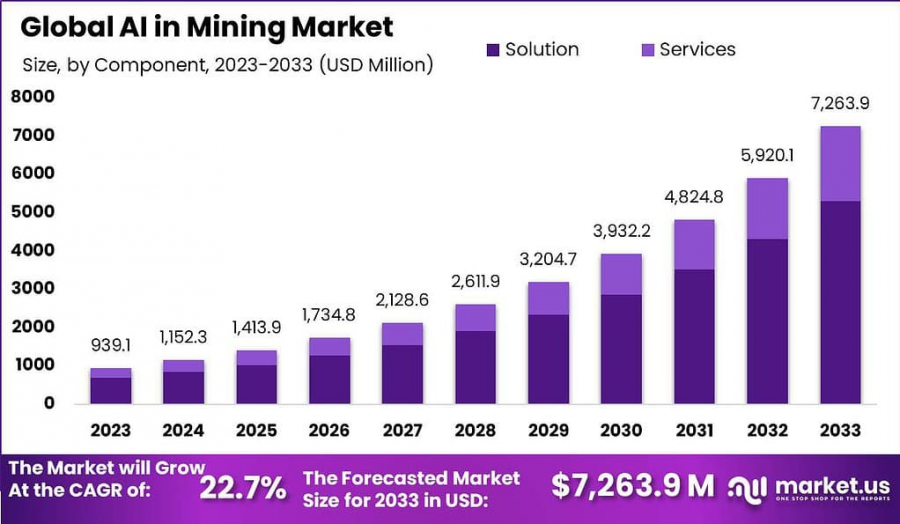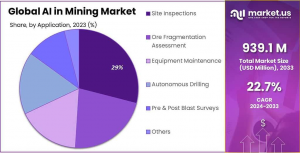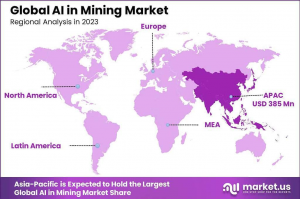
AI in Mining Market Revenue to Soar to USD 7,263.9 Mn by 2033 | Site Inspections at 29%, Asia-Pacific Holds 41% Share
By 2033, the AI in Mining Market is projected to hit USD 7,263.9 million, expanding at an impressive 22.7% CAGR over the forecast period.
NEW YORK, NY, UNITED STATES, January 27, 2025 /EINPresswire.com/ -- AI in Mining Market Size, Share Analysis and Forecast 2024 to 2033
The mining sector is undergoing a significant transformation with the integration of Artificial Intelligence (AI), projected to greatly enhance market dynamics by 2033. AI applications in mining are increasing operational efficiency, improving safety, and reducing environmental impacts. Predictive maintenance and real-time data monitoring are just a few areas where AI is making a substantial difference, leading to notable increases in productivity and cost savings for mining operations.
The major driving forces behind the adoption of AI in mining include the need to enhance operational efficiency, improve safety measures, and reduce environmental footprints. AI-driven technologies such as machine learning and predictive analytics enable mining companies to predict equipment failures, optimize operations, and manage resources more effectively. Furthermore, the pressure to comply with increasingly stringent environmental regulations is pushing the mining industry towards AI innovations that can help achieve sustainable mining practices.
👉 𝐂𝐥𝐢𝐜𝐤 𝐭𝐨 𝐑𝐞𝐪𝐮𝐞𝐬𝐭 𝐒𝐚𝐦𝐩𝐥𝐞 𝐑𝐞𝐩𝐨𝐫𝐭 𝐚𝐧𝐝 𝐃𝐫𝐢𝐯𝐞 𝐈𝐦𝐩𝐚𝐜𝐭𝐟𝐮𝐥 𝐃𝐞𝐜𝐢𝐬𝐢𝐨𝐧𝐬: https://market.us/report/ai-in-mining-market/free-sample/
Current trends in the AI in mining market focus on the deployment of AI for predictive maintenance, real-time data monitoring, and the optimization of mineral processing operations. There is also a growing emphasis on the development of AI solutions that can perform site inspections and ensure compliance with safety and environmental standards. These technologies not only streamline operations but also enhance the accuracy and efficiency of critical mining processes.
For stakeholders, the integration of AI into mining operations translates into several key benefits. These include heightened operational efficiency, enhanced safety protocols, and significant cost reductions. AI technologies provide stakeholders with the tools to make data-driven decisions that optimize production and minimize downtime. Moreover, AI is instrumental in helping mining companies meet regulatory requirements and improve their sustainability efforts, thereby enhancing their market competitiveness and reputation.
AI in Mining Market Key Takeaways
In 2023, the Solution Segment held a dominant position, capturing over 73% of the market, driven by the growing adoption of AI-driven solutions to enhance efficiency and safety in mining operations.
The Site Inspections segment led the market in 2023, securing more than 29% of the share, thanks to advanced technologies like drones equipped with AI for precise, thorough inspections.
Large enterprises were the main contributors to the market in 2023, utilizing their financial strength to invest in cutting-edge AI technologies, boosting efficiency, productivity, and safety.
Asia-Pacific dominated the AI in Mining market in 2023 with over 41% market share, fueled by substantial investments, a strong presence of mining giants, and favorable government policies.
👉 𝐁𝐮𝐲 𝐍𝐨𝐰 𝐭𝐡𝐢𝐬 𝐏𝐫𝐞𝐦𝐢𝐮𝐦 𝐑𝐞𝐩𝐨𝐫𝐭 𝐭𝐨 𝐆𝐫𝐨𝐰 𝐲𝐨𝐮𝐫 𝐁𝐮𝐬𝐢𝐧𝐞𝐬𝐬: https://market.us/purchase-report/?report_id=117811
Artificial Intelligence (AI) Impact on the AI in Mining Market
Finding Minerals More Efficiently: AI helps geologists locate valuable minerals like copper and lithium by analyzing large amounts of geological data. For example, KoBold Metals uses AI to predict where these minerals might be hidden underground, making exploration faster and more accurate.
Improving Safety: Mining can be dangerous, but AI makes it safer. Autonomous vehicles and drones can handle risky tasks such as transporting materials and inspecting hazardous areas, reducing the need for humans to be in harm's way. Companies like Rio Tinto use AI-powered trucks and drills to minimize accidents and enhance safety.
Predicting Equipment Maintenance: AI monitors mining equipment to predict when maintenance is needed, preventing unexpected breakdowns. This approach, known as predictive maintenance, helps keep operations running smoothly and reduces costs. BHP, a major mining company, uses AI to monitor equipment health and schedule timely repairs.
Reducing Environmental Impact: AI assists in minimizing the environmental footprint of mining. By optimizing operations, AI reduces waste and energy consumption. It also helps monitor environmental conditions, ensuring that mining activities comply with regulations and are less harmful to the surrounding ecosystem.
Analyst's Viewpoint
Market Opportunities and Risks
The integration of Artificial Intelligence (AI) into mining is seen as a transformative shift for the industry, primarily aimed at enhancing efficiency and reducing operational costs. AI applications in mining, such as predictive maintenance, can significantly decrease downtime by foreseeing equipment failures, thereby optimizing equipment performance and reducing unexpected maintenance costs. However, as the industry shifts towards more automated operations, the risk of cybersecurity threats increases, necessitating robust security measures to protect sensitive data and operational technology.
Key Applications of AI in Mining
Exploration and geology: AI algorithms analyze geological data to identify potential mineral deposits.
Equipment maintenance: Predictive maintenance algorithms forecast equipment failures.
Safety and risk management: AI enhances mine safety through automated monitoring systems that predict and prevent potential hazards.
Environmental monitoring: AI supports sustainability efforts by optimizing energy use and reducing ecological footprints.
Consumer Awareness and Regulatory Environment
Consumer awareness regarding the benefits of AI in mining is growing, with a focus on sustainability and operational efficiency. However, the mining industry faces challenges related to the regulatory environment, particularly in adhering to environmental regulations and managing social impacts. AI can help mining companies navigate these challenges by providing more accurate data for decision-making and improving compliance with regulatory standards.
The expansion of AI in mining is closely tied to regulatory developments, particularly those aimed at environmental conservation and worker safety. As AI technologies continue to evolve, regulatory frameworks are expected to adapt, potentially leading to stricter controls and guidelines to ensure that the deployment of AI technologies aligns with environmental and safety standards.
Asia-Pacific Size and Growth 2025 to 2034
In 2023, the Asia-Pacific region was at the forefront of the AI-driven solutions market in mining, holding a dominant market share of over 41%. Valued at USD 385.0 million that year, the demand in this region for artificial intelligence technologies in the mining sector is projected to undergo significant growth during the forecast period.
The expansion is driven by factors like growing investments in AI and a focus on improving mining efficiency and safety. Countries like China, Australia, and India are leading in AI adoption, optimizing areas such as exploration, extraction, and processing. This integration boosts efficiency, reduces environmental impact, and enhances decision-making.
Regulatory support and government initiatives in the Asia-Pacific region are further driving growth in the mining industry through technological advancements. As both companies and governments invest in AI to address challenges like resource depletion and labor safety, the market for AI-driven solutions is expected to expand significantly. This reflects a broader shift towards digital transformation in the region’s mining sector.
👉 𝐂𝐥𝐢𝐜𝐤 𝐭𝐨 𝐑𝐞𝐪𝐮𝐞𝐬𝐭 𝐒𝐚𝐦𝐩𝐥𝐞 𝐑𝐞𝐩𝐨𝐫𝐭 𝐚𝐧𝐝 𝐃𝐫𝐢𝐯𝐞 𝐈𝐦𝐩𝐚𝐜𝐭𝐟𝐮𝐥 𝐃𝐞𝐜𝐢𝐬𝐢𝐨𝐧𝐬: https://market.us/report/ai-in-mining-market/request-sample/
Report Segmenation
Component Analysis
In 2023, the solution segment dominated the AI in Mining market, capturing over 73% of the market share. This dominance reflects the growing reliance on AI-powered solutions for various mining operations, such as automation, predictive maintenance, and data analysis. These solutions help mining companies improve efficiency, reduce operational costs, and enhance safety by leveraging machine learning algorithms and advanced analytics.
Application Analysis
The site inspections segment also held a significant position within the AI in Mining market, capturing more than 29% of the market share in 2023. This growth is primarily driven by the use of AI technologies such as drones, robotics, and sensors to conduct remote and automated site inspections. These technologies enable mining companies to assess and monitor their operations more efficiently and safely, reducing the risks associated with manual inspections.
Enterprise Size Analysis
In 2023, large enterprises held a dominant position in the AI in Mining market, capturing a substantial share. This can be attributed to the larger budgets and resources of these enterprises, enabling them to invest in advanced AI technologies. Large mining companies are more likely to implement AI solutions at scale, incorporating AI into various aspects of their operations, from exploration to production and safety management.
Market Dynamics
Driver: Enhancing Operational Efficiency
The integration of AI in the mining sector primarily drives operational efficiency. AI technologies enable predictive maintenance, which uses real-time data to forecast equipment failures before they happen, reducing downtime and maintenance costs. Additionally, AI optimizes mining processes by analyzing extensive data from various mining stages to improve resource extraction and waste reduction. For instance, companies like Rio Tinto have utilized AI-driven autonomous haulage systems that enhance the efficiency and safety of their operations.
Restraint: High Initial Costs and Data Challenges
The adoption of AI technologies in mining faces significant restraints, including the high initial investment required for advanced hardware and software. Additionally, the success of AI applications depends heavily on the quality and quantity of data available. Mining companies often struggle with establishing the necessary data infrastructure and integrating diverse data sets, which hinders the effective implementation of AI.
Opportunity: Improving Safety and Environmental Practices
AI offers substantial opportunities to improve safety and environmental sustainability in the mining industry. By predicting potential hazards, AI enables preemptive actions to protect workers. It also facilitates the use of autonomous vehicles and drones to perform dangerous tasks, reducing human exposure to hazardous conditions. Moreover, AI can monitor environmental conditions, helping to minimize the impact of mining activities on the surrounding ecosystem.
Challenge: Cultural Resistance and Skill Gaps
Implementing AI in mining is challenged by cultural resistance within the industry. Traditional mining operations are deeply ingrained, and shifting to AI-driven methods requires a significant change in both mindset and skills. There is a need for comprehensive training programs to ensure that the workforce can adeptly use new technologies. Overcoming these cultural and training barriers is essential for the successful integration of AI into mining practices.
Emerging Trends
Enhancing Mineral Exploration: AI helps geologists find new mineral deposits by analyzing vast amounts of geological data. For instance, KoBold Metals uses AI to locate essential metals like copper and lithium, leading to significant discoveries in places like Zambia.
Improving Operational Efficiency: By adopting AI and other emerging technologies, mining companies can address critical challenges such as efficiency and safety. This transformation is helping the sector become more productive and secure.
Advancing Sustainable Practices: AI and data analytics are being used to assess and oversee environmental, social, and governance (ESG) performance in mining. This approach supports responsible resource extraction and helps companies meet sustainability goals.
Optimizing Resource Extraction: AI is utilized to enhance the efficiency of resource extraction processes. For example, Quantum Blockchain Technologies has developed an AI model that reportedly improves bitcoin mining efficiency by predicting winning blocks, potentially reducing energy consumption or increasing mining speed by approximately 30%.
Addressing Workforce Challenges: The integration of AI in mining necessitates new skills, such as coding and robotics engineering. This shift is prompting the industry to focus on attracting and training talent equipped to handle these advanced technologies.
Top Use Cases
Finding New Mineral Deposits: AI helps geologists analyze large amounts of data to locate valuable minerals like copper and lithium. For example, companies use AI to predict where these minerals might be hidden underground, making exploration more efficient.
Predicting Equipment Maintenance: By monitoring machinery in real-time, AI can foresee when equipment might fail. This allows for timely maintenance, reducing unexpected breakdowns and keeping operations running smoothly.
Improving Safety with Autonomous Vehicles: AI powers self-driving trucks and drills in mines, taking over dangerous tasks from humans. This not only enhances safety but also boosts productivity by allowing continuous operation.
Monitoring Environmental Impact: AI systems track air and water quality around mining sites, helping companies detect pollution early and comply with environmental regulations. This proactive approach supports sustainable mining practices.
Enhancing Ore Processing: AI assists in sorting and processing mined materials more efficiently. By analyzing the composition of ores, AI can optimize the extraction process, leading to better resource utilization and reduced waste.
Major Challenges
High Initial Costs: Introducing AI technologies requires significant investment in advanced hardware, software, and skilled personnel. This substantial upfront cost can be a barrier for many mining companies.
Data Quality and Availability: AI systems depend on large volumes of high-quality data to function effectively. However, many mining operations struggle with collecting and managing the necessary data, which can hinder AI performance.
Workforce Resistance: Transitioning to AI-driven methods requires a cultural shift within the industry. There can be resistance from workers accustomed to traditional practices, necessitating comprehensive training programs to facilitate the change.
Environmental Concerns: The mining sector faces growing environmental challenges. AI and advanced technologies can assist companies in meeting regulatory requirements and minimizing their environmental footprint.
Cybersecurity Risks: As mining operations become more digitalized with AI integration, they become more vulnerable to cyberattacks. Ensuring robust cybersecurity measures is essential to protect sensitive data and maintain operational integrity.
Market Opportunities for Key Players
Predictive Maintenance: AI can significantly improve equipment uptime through predictive maintenance. By using data from sensors and historical trends, AI can forecast when equipment is likely to fail, allowing companies to carry out maintenance before a breakdown happens. This reduces downtime and extends the lifespan of expensive mining machinery. Mining companies can save on repair costs and ensure operations run smoothly.
Autonomous Vehicles and Drones: Mining companies are increasingly adopting AI-driven autonomous vehicles and drones for tasks like transporting materials and surveying mines. Autonomous trucks, drills, and drones can work continuously, reducing labor costs and enhancing productivity. Drones, equipped with AI, can also be used to monitor mine safety and environmental conditions in real-time, improving decision-making and reducing risks.
Resource Exploration and Data Analysis: AI-powered systems are transforming the exploration process. Machine learning algorithms can analyze geological data faster and more accurately than traditional methods. This helps companies identify new mineral deposits, improving the success rate of exploration. Additionally, AI can be used to optimize mine planning, ensuring the most efficient use of resources.
Safety and Risk Management: AI applications in safety monitoring can detect potential hazards in real time, such as gas leaks or equipment malfunctions, and alert workers or supervisors immediately. AI can also be used to analyze safety data, predict accidents, and suggest preventive measures. This not only protects workers but also helps in regulatory compliance, ensuring a safer working environment.
Market Companies
- Rio Tinto
- Infosys
- Accenture
- Goldspot Discoveries Inc.
- Drone Deploy
- Kore Geosystems
- TOMRA
- Earth AI
- Minerva Intelligence
- Other Key Players
Recent Developments
Partnership with Fleet Space Technologies (November 2024): Rio Tinto announced a collaboration to utilize AI for creating 3D maps of its Rincon lithium project in Argentina. This initiative aims to enhance subsurface mapping and improve operational efficiency through advanced AI technology.
Conclusion
In summary, the integration of AI in the mining industry has the potential to revolutionize operations by enhancing efficiency, safety, and sustainability. AI technologies such as machine learning, data analytics, and automation are optimizing processes from exploration to extraction, reducing operational costs, and minimizing environmental impact. These advancements not only improve productivity but also support more informed decision-making, leading to better resource management.
Furthermore, as the demand for minerals grows globally, AI offers a competitive edge by enabling mining companies to adapt to challenges such as fluctuating market conditions and regulatory pressures. With continued investment and innovation, AI is expected to drive further growth in the mining sector, paving the way for smarter, more sustainable mining practices that align with industry trends and global sustainability goals.
Lawrence John
Prudour
+91 91308 55334
Lawrence@prudour.com
Visit us on social media:
Facebook
LinkedIn
Distribution channels: Technology
Legal Disclaimer:
EIN Presswire provides this news content "as is" without warranty of any kind. We do not accept any responsibility or liability for the accuracy, content, images, videos, licenses, completeness, legality, or reliability of the information contained in this article. If you have any complaints or copyright issues related to this article, kindly contact the author above.
Submit your press release


